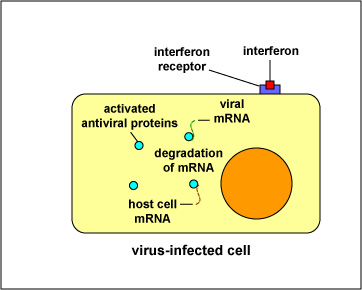Fig. 3: Antiviral Action of Interferon,
Step-2

Produced by immune-activated cells
or virus-infected cells in response to the double-stranded RNA (dsRNA) that
many viruses produce as a part of their life cycle, interferons exert their
antiviral activity by binding to uninfected neighboring cells and inducing them
to produce enzymes that degrade mRNA. This not only prevents translation of
viral mRNA into viral protein it also eventually kills the host cell,
the factory producing the viruses. Interferons also enhance body defenses against
viruses by enhancing the activities of CTLs, macrophages, NK cells, and antibody-producing
cells.
Illustration of Antiviral Action of Interferon, Step-2 .jpg by Gary E. Kaiser, Ph.D.
Professor of Microbiology,
The Community College of Baltimore County, Catonsville Campus
This work is licensed under a Creative Commons Attribution 4.0 International License.
Based on a work at https://cwoer.ccbcmd.edu/science/microbiology/index_gos.html.

Last updated: Feb., 2021
Please send comments and inquiries to Dr.
Gary Kaiser
